Optic Nerve Head Curvature Flattening Is Associated with Central Visual Field Scotoma
Abstract
:1. Introduction
2. Materials and Methods
2.1. Measuring Optic Nerve Head Curvature
2.2. Calculation of the Average Curvature Ratio, Expected Tilt Angle, and Vertical–Horizontal Ratio
2.3. Visual Field Examination and Definition of Glaucomatous Scotoma
- (1)
- Patella–Anderson criteria [24]: in each central or peripheral region, a cluster of three or more points had a p-value < 5%, one of which had a p-value < 1% for the pattern deviation probability map.
- (2)
- Kook’s criteria [25]: in each central or peripheral region, three or more adjacent points with a p-value < 5% or two or more test points with a p-value < 2% or less on a pattern deviation probability map.
2.4. Statistical Analyses
3. Results
4. Discussion
5. Conclusions
Author Contributions
Funding
Institutional Review Board Statement
Informed Consent Statement
Data Availability Statement
Conflicts of Interest
References
- Morgan, I.G.; Ohno-Matsui, K.; Saw, S.-M. Myopia. Lancet 2012, 379, 1739–1748. [Google Scholar] [CrossRef] [PubMed]
- Holden, B.A.; Fricke, T.R.; Wilson, D.A.; Jong, M.; Naidoo, K.S.; Sankaridurg, P.; Wong, T.Y.; Naduvilath, T.J.; Resnikoff, S. Global Prevalence of Myopia and High Myopia and Temporal Trends from 2000 through 2050. Ophthalmology 2016, 123, 1036–1042. [Google Scholar] [CrossRef]
- Marcus, M.W.; de Vries, M.M.; Montolio, F.G.J.; Jansonius, N.M. Myopia as a Risk Factor for Open-Angle Glaucoma: A Systematic Review and Meta-Analysis. Ophthalmology 2011, 118, 1989–1994.e2. [Google Scholar] [CrossRef] [PubMed]
- Mitchell, P.; Hourihan, F.; Sandbach, J.; Wang, J.J. The Relationship between Glaucoma and Myopia: The Blue Mountains Eye Study. Ophthalmology 1999, 106, 2010–2015. [Google Scholar] [CrossRef] [PubMed]
- Hong, K.E.; Kim, S.A.; Shin, D.-Y.; Park, C.K.; Park, H.-Y.L. Ocular and Hemodynamic Factors Contributing to the Central Visual Function in Glaucoma Patients with Myopia. Investig. Ophthalmol. Vis. Sci. 2022, 63, 26. [Google Scholar] [CrossRef]
- Nitta, K.; Sugiyama, K.; Wajima, R.; Tachibana, G. Is High Myopia a Risk Factor for Visual Field Progression or Disk Hemorrhage in Primary Open-Angle Glaucoma? Clin. Ophthalmol. 2017, 11, 599–604. [Google Scholar] [CrossRef]
- Jonas, J.B.; Ohno-Matsui, K.; Panda-Jonas, S. Myopia: Anatomic Changes and Consequences for Its Etiology. Asia-Pac. J. Ophthalmol. 2019, 8, 355–359. [Google Scholar] [CrossRef]
- Jonas, J.B.; Jonas, R.A.; Bikbov, M.M.; Wang, Y.X.; Panda-Jonas, S. Myopia: Histology, Clinical Features, and Potential Implications for the Etiology of Axial Elongation. Prog. Retin. Eye Res. 2023, 96, 101156. [Google Scholar] [CrossRef]
- Chang, L.; Pan, C.-W.; Ohno-Matsui, K.; Lin, X.; Cheung, G.C.; Gazzard, G.; Koh, V.; Hamzah, H.; Tai, E.S.; Lim, S.C. Myopia-Related Fundus Changes in Singapore Adults with High Myopia. Am. J. Ophthalmol. 2013, 155, 991–999.e1. [Google Scholar] [CrossRef]
- Park, H.-Y.; Hwang, Y.S.; Park, C.K. Ocular Characteristics Associated with the Location of Focal Lamina Cribrosa Defects in Open-Angle Glaucoma Patients. Eye 2017, 31, 578–587. [Google Scholar] [CrossRef]
- Choi, J.A.; Park, H.-Y.L.; Shin, H.-Y.; Park, C.K. Optic Disc Characteristics in Patients with Glaucoma and Combined Superior and Inferior Retinal Nerve Fiber Layer Defects. JAMA Ophthalmol. 2014, 132, 1068–1075. [Google Scholar] [CrossRef] [PubMed]
- Lyu, I.J.; Park, K.-A.; Oh, S.Y. Association between Myopia and Peripapillary Hyperreflective Ovoid Mass-like Structures in Children. Sci. Rep. 2020, 10, 2238. [Google Scholar] [CrossRef] [PubMed]
- Jonas, J.B.; Wang, Y.X.; Zhang, Q.; Fan, Y.Y.; Xu, L.; Wei, W.B.; Jonas, R.A. Parapapillary Gamma Zone and Axial Elongation–Associated Optic Disc Rotation: The Beijing Eye Study. Investig. Ophthalmol. Vis. Sci. 2016, 57, 396–402. [Google Scholar] [CrossRef] [PubMed]
- Yamashita, T.; Sakamoto, T.; Yoshihara, N.; Terasaki, H.; Tanaka, M.; Kii, Y.; Nakao, K. Correlations between Local Peripapillary Choroidal Thickness and Axial Length, Optic Disc Tilt, and Papillo-Macular Position in Young Healthy Eyes. PLoS ONE 2017, 12, e0186453. [Google Scholar] [CrossRef] [PubMed]
- Sawada, Y.; Hangai, M.; Ishikawa, M.; Yoshitomi, T. Association of Myopic Optic Disc Deformation with Visual Field Defects in Paired Eyes with Open-Angle Glaucoma: A Cross-Sectional Study. PLoS ONE 2016, 11, e0161961. [Google Scholar] [CrossRef]
- Choi, J.H.; Han, J.C.; Kee, C. The Effects of Optic Nerve Head Tilt on Visual Field Defects in Myopic Normal Tension Glaucoma: The Intereye Comparison Study. J. Glaucoma 2019, 28, 341–346. [Google Scholar] [CrossRef]
- Samarawickrama, C.; Mitchell, P.; Tong, L.; Gazzard, G.; Lim, L.; Wong, T.-Y.; Saw, S.-M. Myopia-Related Optic Disc and Retinal Changes in Adolescent Children from Singapore. Ophthalmology 2011, 118, 2050–2057. [Google Scholar] [CrossRef]
- Kim, T.-W.; Kim, M.; Weinreb, R.N.; Woo, S.J.; Park, K.H.; Hwang, J.-M. Optic Disc Change with Incipient Myopia of Childhood. Ophthalmology 2012, 119, 21–26.e3. [Google Scholar] [CrossRef]
- Lee, E.J.; Han, J.C.; Kee, C. Relationship between Anterior Lamina Cribrosa Surface Tilt and Glaucoma Development in Myopic Eyes. J. Glaucoma 2017, 26, 415–422. [Google Scholar] [CrossRef]
- Lee, K.M.; Choung, H.-K.; Kim, M.; Oh, S.; Kim, S.H. Positional Change of Optic Nerve Head Vasculature during Axial Elongation as Evidence of Lamina Cribrosa Shifting: Boramae Myopia Cohort Study Report 2. Ophthalmology 2018, 125, 1224–1233. [Google Scholar] [CrossRef]
- Sawada, A.; Tomidokoro, A.; Araie, M.; Iwase, A.; Yamamoto, T.; Group, T.S. Refractive Errors in an Elderly Japanese Population: The Tajimi Study. Ophthalmology 2008, 115, 363–370.e3. [Google Scholar] [CrossRef] [PubMed]
- Xu, L.; Li, J.; Cui, T.; Hu, A.; Fan, G.; Zhang, R.; Yang, H.; Sun, B.; Jonas, J.B. Refractive Error in Urban and Rural Adult Chinese in Beijing. Ophthalmology 2005, 112, 1676–1683. [Google Scholar] [CrossRef] [PubMed]
- Yohannan, J.; Wang, J.; Brown, J.; Chauhan, B.C.; Boland, M.V.; Friedman, D.S.; Ramulu, P.Y. Evidence-Based Criteria for Assessment of Visual Field Reliability. Ophthalmology 2017, 124, 1612–1620. [Google Scholar] [CrossRef] [PubMed]
- Anderson, D.R. Automated Static Perimetry; Mosby-Year Book: St. Louis, MO, USA, 1999; p. 152. [Google Scholar]
- Kwon, J.; Choi, J.; Shin, J.W.; Lee, J.; Kook, M.S. Alterations of the Foveal Avascular Zone Measured by Optical Coherence Tomography Angiography in Glaucoma Patients with Central Visual Field Defects. Investig. Ophthalmol. Vis. Sci. 2017, 58, 1637–1645. [Google Scholar] [CrossRef] [PubMed]
- Greene, P.R. Mechanical Considerations in Myopia: Relative Effects of Accommodation, Convergence, Intraocular Pressure, and the Extraocular Muscles. Optom. Vis. Sci. 1980, 57, 902–914. [Google Scholar] [CrossRef]
- Demer, J.L. Optic Nerve Sheath as a Novel Mechanical Load on the Globe in Ocular Duction. Investig. Ophthalmol. Vis. Sci. 2016, 57, 1826–1838. [Google Scholar] [CrossRef] [PubMed]
- Kimura, Y.; Hangai, M.; Morooka, S.; Takayama, K.; Nakano, N.; Nukada, M.; Ikeda, H.O.; Akagi, T.; Yoshimura, N. Retinal Nerve Fiber Layer Defects in Highly Myopic Eyes with Early Glaucoma. Investig. Ophthalmol. Vis. Sci. 2012, 53, 6472–6478. [Google Scholar] [CrossRef]
- Tay, E.; Seah, S.K.; Chan, S.-P.; Lim, A.T.; Chew, S.-J.; Foster, P.J.; Aung, T. Optic Disk Ovality as an Index of Tilt and Its Relationship to Myopia and Perimetry. Am. J. Ophthalmol. 2005, 139, 247–252. [Google Scholar] [CrossRef]
- Hyung, S.M.; Kim, D.M.; Hong, C.; Youn, D.H. Optic Disc of the Myopic Eye: Relationship between Refractive Errors and Morphometric Characteristics. Korean J. Ophthalmol. 1992, 6, 32–35. [Google Scholar] [CrossRef]
- Lim, L.; Gazzard, G.; Chan, Y.-H.; Fong, A.; Kotecha, A.; Sim, E.-L.; Tan, D.; Tong, L.; Saw, S.-M. Corneal Biomechanics, Thickness and Optic Disc Morphology in Children with Optic Disc Tilt. Br. J. Ophthalmol. 2008, 92, 1461–1466. [Google Scholar] [CrossRef]
- Han, J.C.; Lee, E.J.; Kim, S.B.; Kee, C. The Characteristics of Deep Optic Nerve Head Morphology in Myopic Normal Tension Glaucoma. Investig. Ophthalmol. Vis. Sci. 2017, 58, 2695–2704. [Google Scholar] [CrossRef] [PubMed]
- Cheng, D.; Ruan, K.; Wu, M.; Qiao, Y.; Gao, W.; Lian, H.; Shen, M.; Bao, F.; Yang, Y.; Zhu, J. Characteristics of the Optic Nerve Head in Myopic Eyes Using Swept-Source Optical Coherence Tomography. Investig. Ophthalmol. Vis. Sci. 2022, 63, 20. [Google Scholar] [CrossRef] [PubMed]
- Asai, T.; Ikuno, Y.; Akiba, M.; Kikawa, T.; Usui, S.; Nishida, K. Analysis of Peripapillary Geometric Characters in High Myopia Using Swept-Source Optical Coherence Tomography. Investig. Ophthalmol. Vis. Sci. 2016, 57, 137–144. [Google Scholar] [CrossRef] [PubMed]
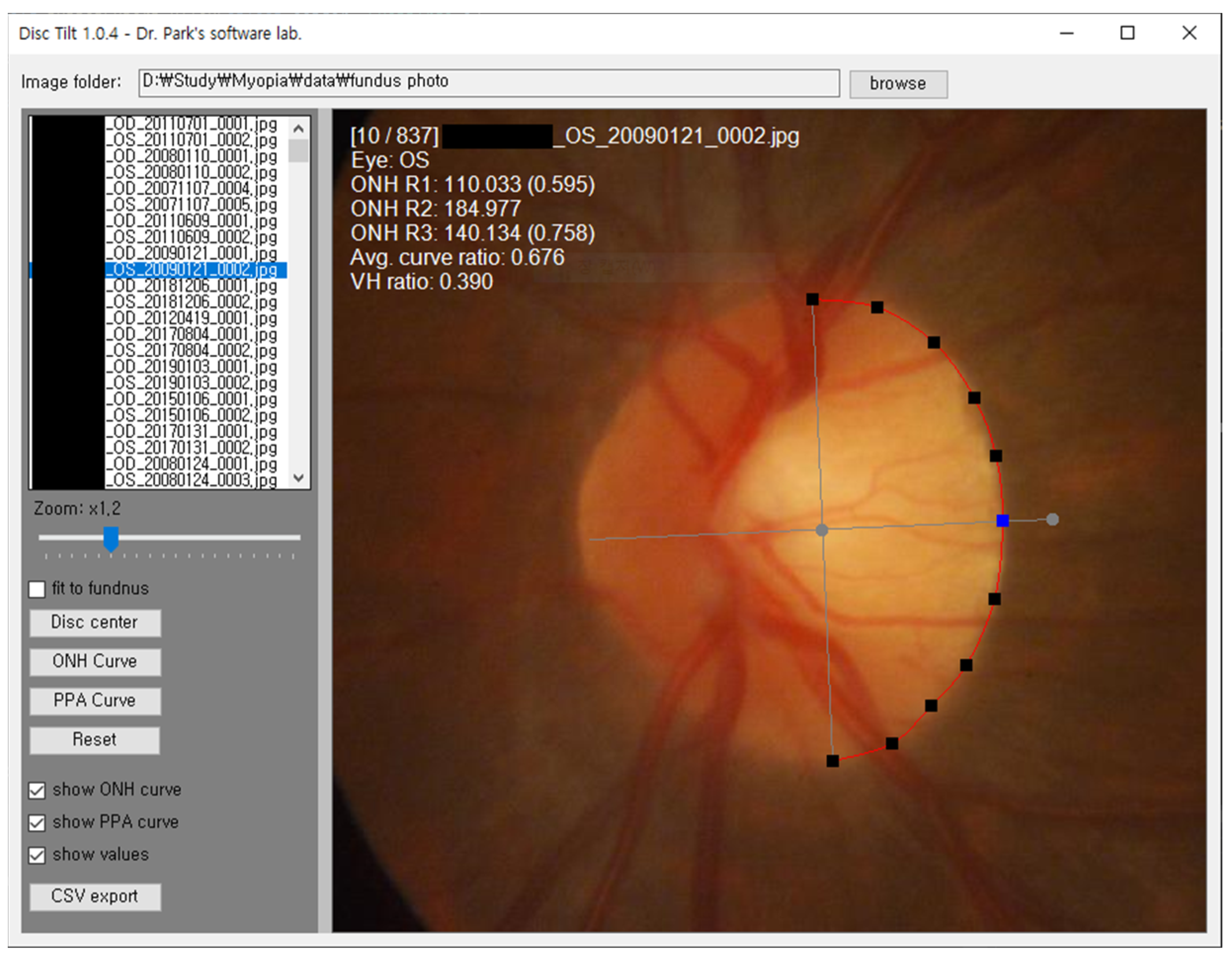
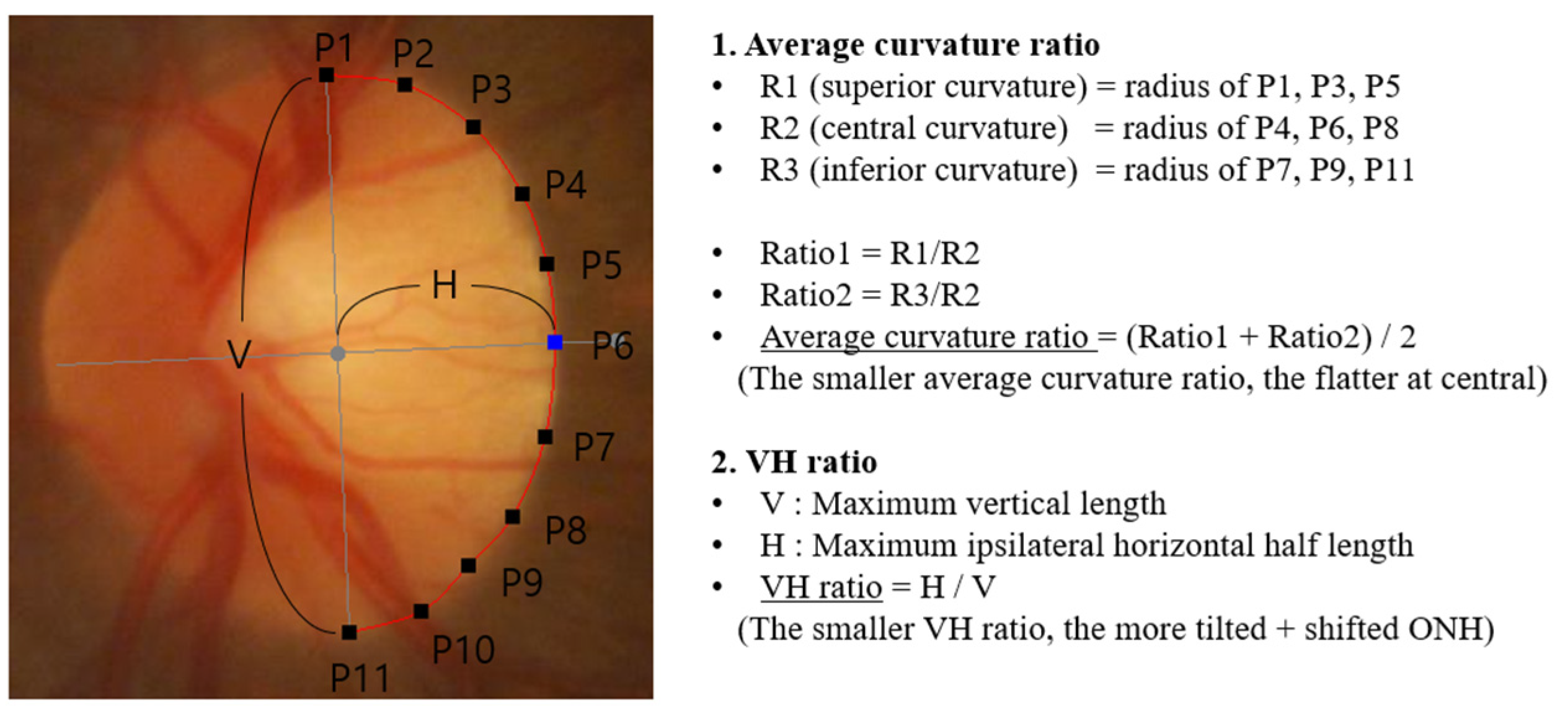
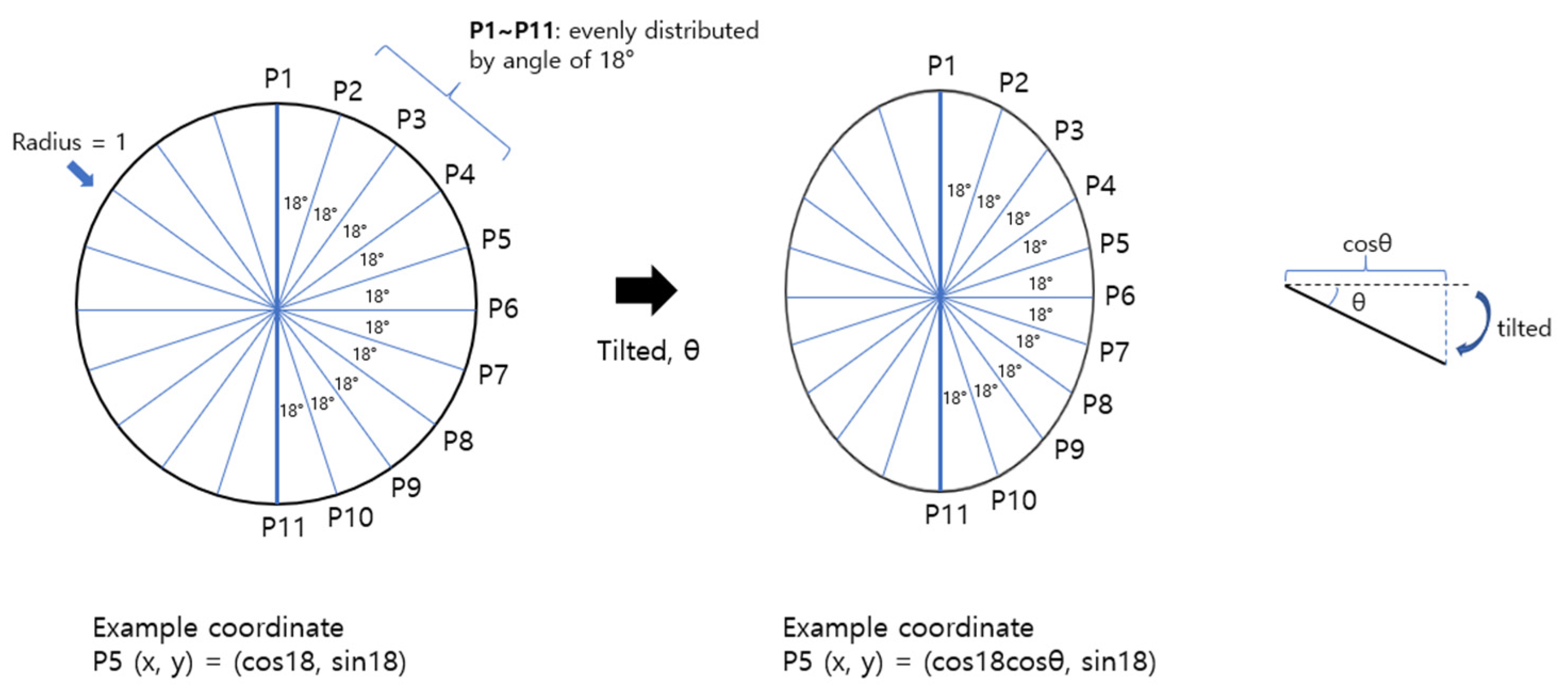

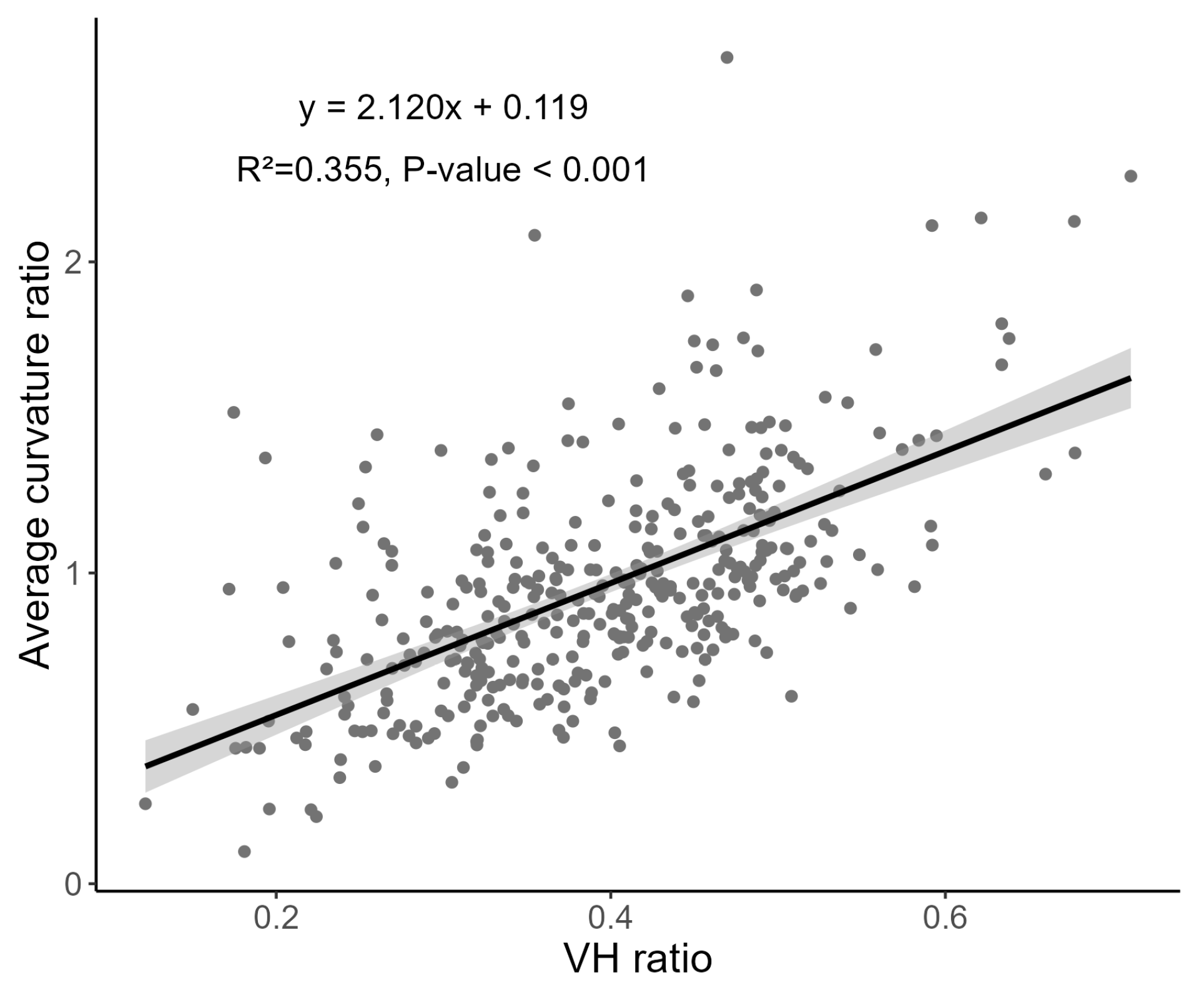
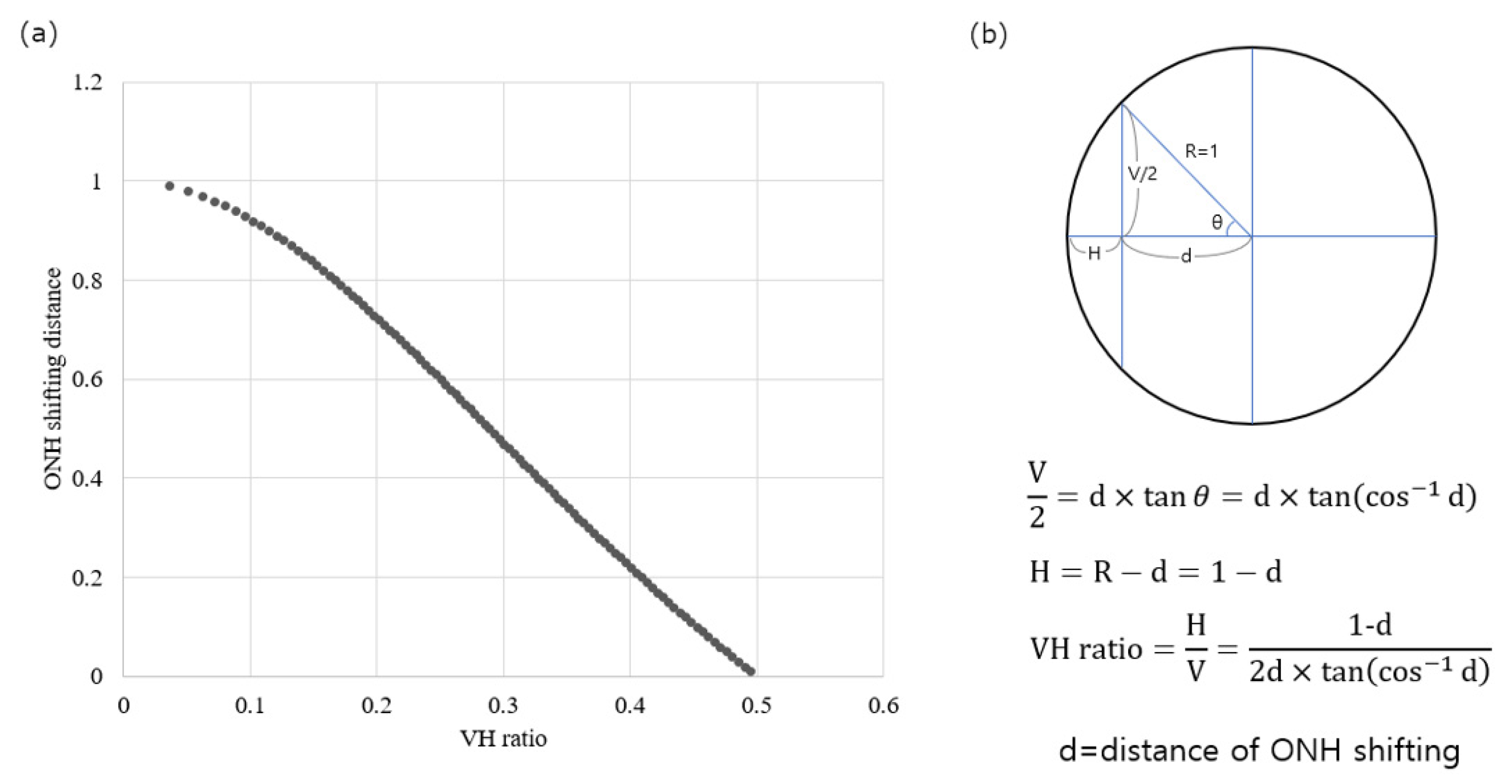
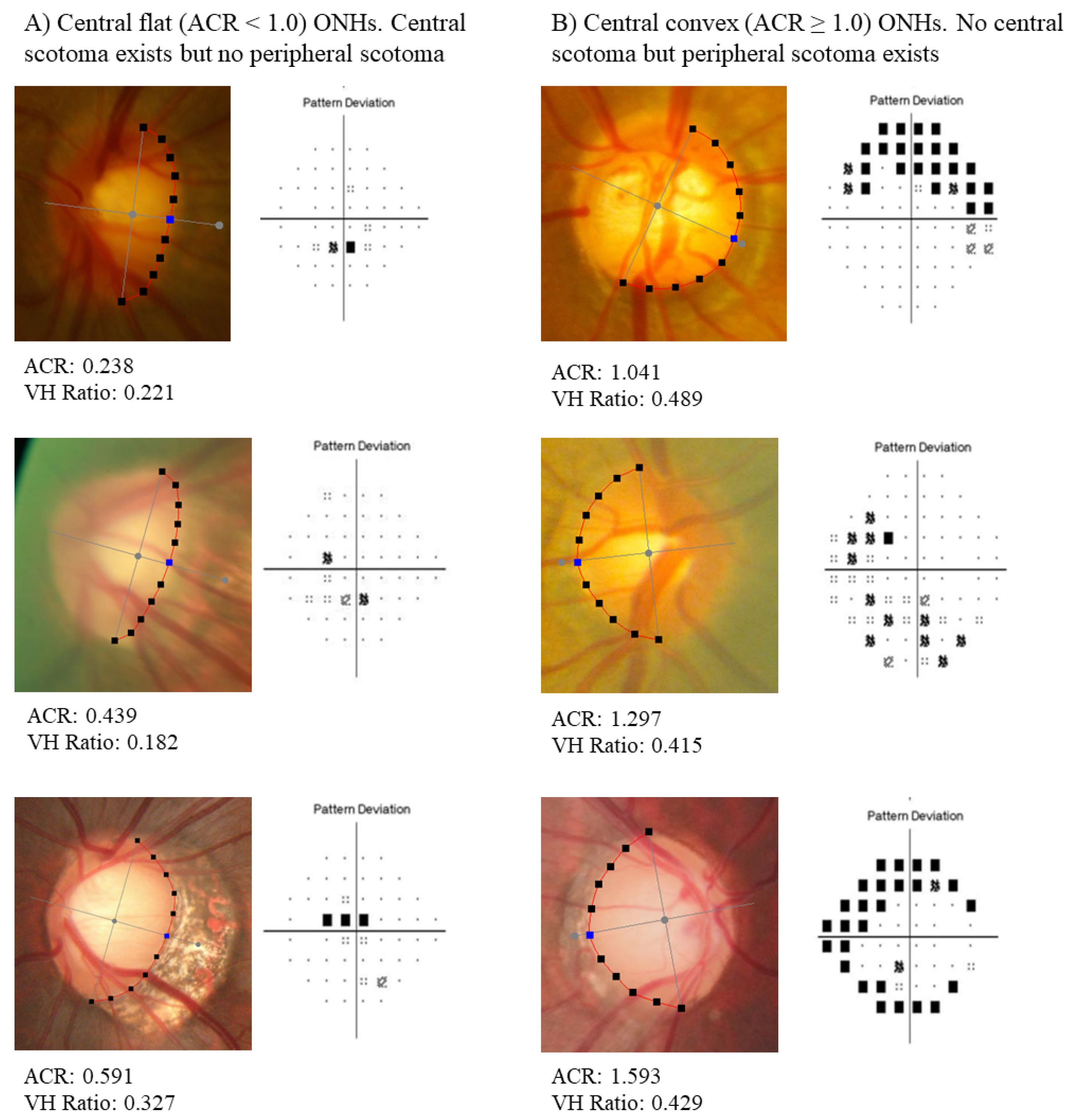
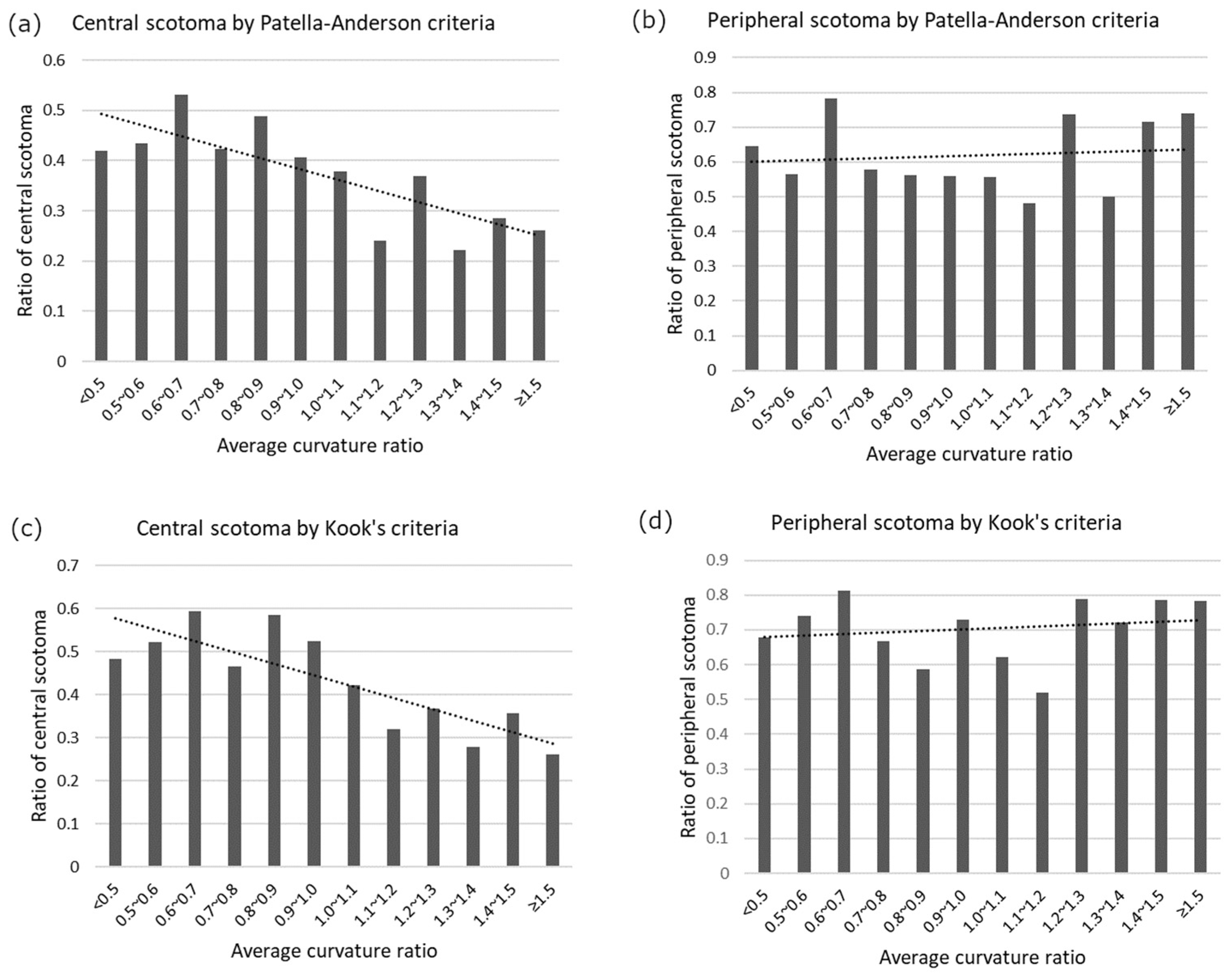
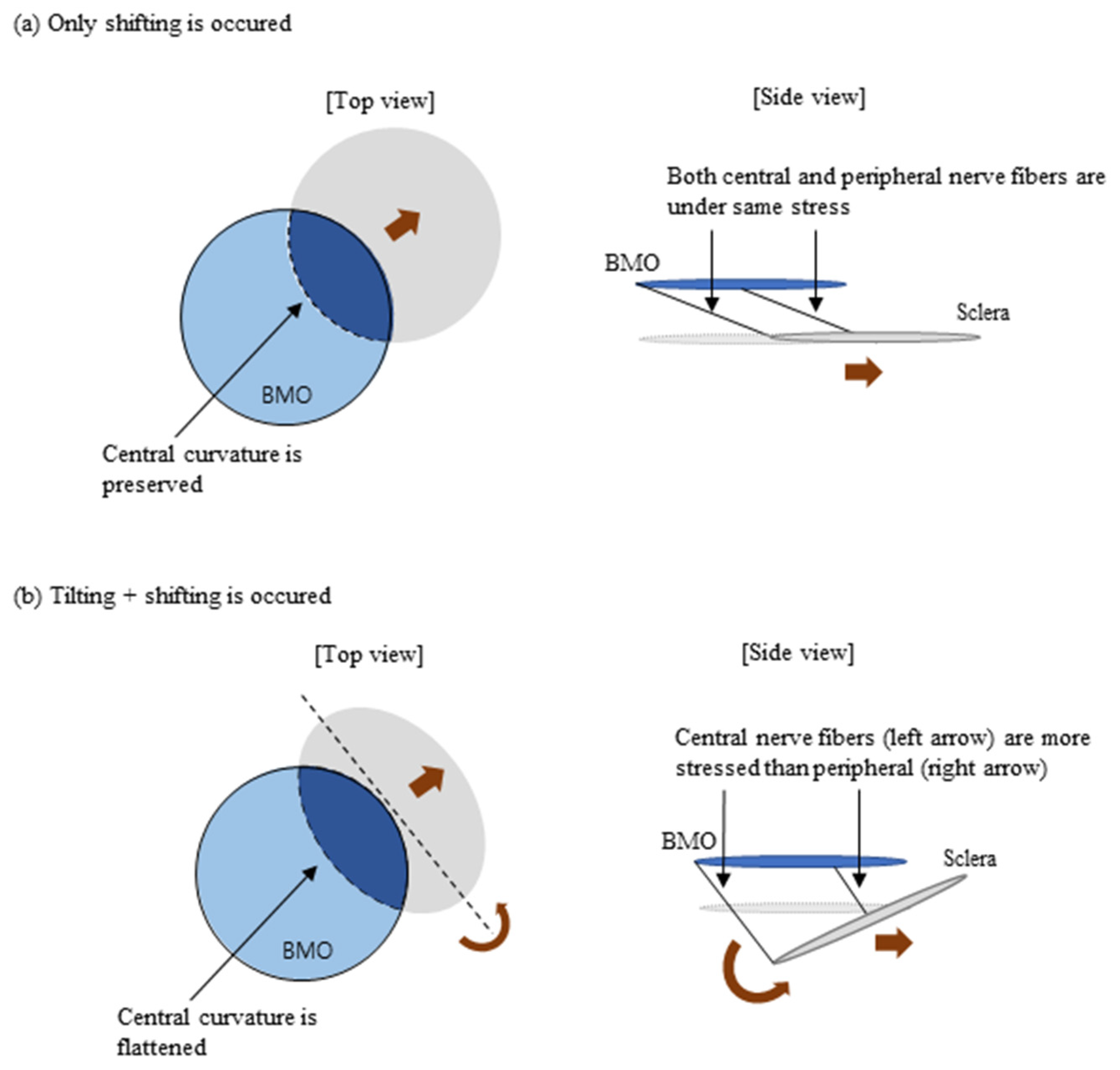
| Flat ONH 1 | Convex ONH 2 | p-Value | |
|---|---|---|---|
| Number of eyes | 231 (61.6%) | 144 (38.4%) | |
| Average curvature ratio | 0.74 ± 0.19 | 1.30 ± 0.29 | <0.001 3 |
| Age (years) | 39.8 ± 12.2 | 41.4 ± 12.5 | 0.276 4 |
| Gender (male/female) | 121/110 | 74/74 | 0.546 5 |
| Refractive error (spherical equivalent, Diopter) | –5.64 ± 2.69 | –5.22 ± 2.42 | 0.173 3 |
| Intraocular pressure (mmHg) | 17.0 ± 4.5 | 16.4 ± 5.3 | 0.212 3 |
| Axial length (mm) | 26.07 ± 1.48 | 25.93 ± 1.55 | 0.546 4 |
| Central corneal thickness (μm) | 555.2 ± 35.8 | 557.3 ± 50.1 | 0.234 4 |
| Visual field global indices | |||
| -Mean deviation (dB) | –5.89 ± 6.06 | –5.72 ± 6.39 | 0.793 3 |
| -Pattern standard deviation (dB) | 5.60 ± 4.65 | 4.85 ± 4.23 | 0.119 3 |
| -Visual Field Index (%) | 86.8 ± 18.04 | 87.52 ± 19.25 | 0.713 3 |
| Flat ONH (N = 231) | Convex ONH (N = 144) | p-Value 1 | |
|---|---|---|---|
| Central scotoma (no. of eyes) | |||
| By Patella–Anderson criteria | 103 (44.6%) | 44 (30.6%) | 0.009 |
| By Kook’s criteria | 122 (52.8%) | 50 (34.7%) | <0.001 |
| Peripheral scotoma (no. of eyes) | |||
| By Patella–Anderson criteria | 140 (60.6%) | 87 (60.4%) | 1.000 |
| By Kook’s criteria | 161 (69.7%) | 98 (68.1%) | 0.826 |
| Factors | Rho 1 | p-Value 1 |
|---|---|---|
| Spherical equivalence | 0.158 | 0.005 |
| Axial length | –0.098 | 0.075 |
| Central corneal thickness | 0.050 | 0.476 |
Disclaimer/Publisher’s Note: The statements, opinions and data contained in all publications are solely those of the individual author(s) and contributor(s) and not of MDPI and/or the editor(s). MDPI and/or the editor(s) disclaim responsibility for any injury to people or property resulting from any ideas, methods, instructions or products referred to in the content. |
© 2024 by the authors. Licensee MDPI, Basel, Switzerland. This article is an open access article distributed under the terms and conditions of the Creative Commons Attribution (CC BY) license (https://creativecommons.org/licenses/by/4.0/).
Share and Cite
Park, K.; Kim, J.; Lee, J. Optic Nerve Head Curvature Flattening Is Associated with Central Visual Field Scotoma. J. Clin. Med. 2024, 13, 596. https://doi.org/10.3390/jcm13020596
Park K, Kim J, Lee J. Optic Nerve Head Curvature Flattening Is Associated with Central Visual Field Scotoma. Journal of Clinical Medicine. 2024; 13(2):596. https://doi.org/10.3390/jcm13020596
Chicago/Turabian StylePark, Keunheung, Jinmi Kim, and Jiwoong Lee. 2024. "Optic Nerve Head Curvature Flattening Is Associated with Central Visual Field Scotoma" Journal of Clinical Medicine 13, no. 2: 596. https://doi.org/10.3390/jcm13020596
APA StylePark, K., Kim, J., & Lee, J. (2024). Optic Nerve Head Curvature Flattening Is Associated with Central Visual Field Scotoma. Journal of Clinical Medicine, 13(2), 596. https://doi.org/10.3390/jcm13020596







